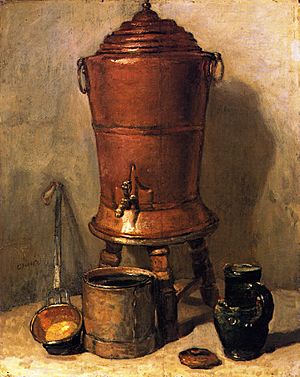The Copper Cistern facts for kids
The Copper Cistern is a famous oil painting created by the French artist Jean-Baptiste-Siméon-Chardin. He painted it around the year 1735. This artwork is quite small, measuring about 28.5 centimeters by 23 centimeters. Today, you can find it displayed at the amazing Louvre Museum in Paris, France.
Contents
Discovering The Copper Cistern Painting
The Copper Cistern is a beautiful example of Chardin's work. It shows a simple, everyday object. Chardin was known for painting scenes from ordinary life. These types of paintings were very popular with everyone in Paris during the 1700s. People enjoyed seeing familiar things in art.
Who Was Jean-Baptiste-Siméon-Chardin?
Jean-Baptiste-Siméon-Chardin was a very talented French painter from the 1700s. He was born in Paris in 1699. Chardin became famous for his still-life paintings and scenes of daily life. He often painted objects found in homes, like kitchen tools or food. He also painted portraits of children and women doing chores. His art showed the beauty in simple, everyday moments.
What Does The Copper Cistern Show?
This painting focuses on a copper cistern. A cistern is like a large container used to hold water. In Chardin's time, these were common household items. The painting shows the cistern up close, making it the main subject. Chardin was very good at showing different textures. You can almost feel the smooth, shiny copper. He also used light and shadow to make the object look real.
Where Can You See This Painting?
The Copper Cistern is part of the collection at the Louvre Museum. The Louvre is one of the largest and most famous art museums in the world. It is located in Paris, France. Many people visit the Louvre each year to see incredible artworks. These include the Mona Lisa and the Venus de Milo. Seeing The Copper Cistern there lets you appreciate Chardin's skill up close.


